I began shooting drop and splash shots three
years ago. I was the amateur photographer wanting to recreate
intriguing high-speed shots we have all seen. It seemed complicated
enough
to be a challenge, but within reach. As I achieved some competence,
a few new challenges would diabolically arrive to egg me on.
I have now taken 20,000 pictures of drops. I still have new
things to try and challenges luring me.
I use a digital SLR (Canon
20D), a 180mm macro lens, Vivitar flashes, and a homemade electronic
timing/control circuit. The
immediate
feedback of digital has made it possible for me to learn quickly
from my plentiful mistakes. The 180mm lens provides the working
distance, excellent optics, and magnification I need. I modified
the flashes so I can manually adjust the duration of the burst
of light. Much of my custom timing/control circuitry could now
be replaced with off-the-shelf components.
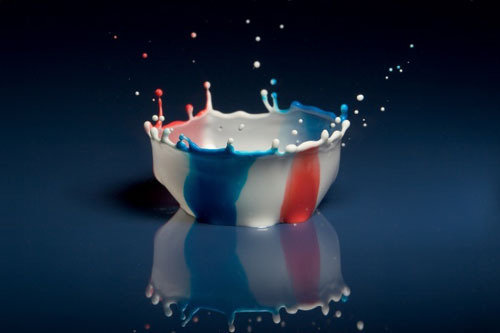
I started with milk. It is the classic subject, and for good
reasons. It is almost opaque, so it reflects light, but its slight
translucence
provides an organic feel. And, its gentle viscosity creates pleasing
forms. Water is more difficult.

To capture water drop splashes I constantly manage
three competing realities:
- Light is the currency of macro photography;
it buys us time and
depth of field.
- The brief flash required to stop the motion
does not provide much light.
- Water is transparent, so it doesn’t
reflect much light.
Often, when I’m shooting water splashes,
my main light is a backlight with a gelled flash. Since the
camera is looking
straight
at the reflection of the flash, I get the light I need. Choosing
appropriate gels creates a variety of backgrounds.
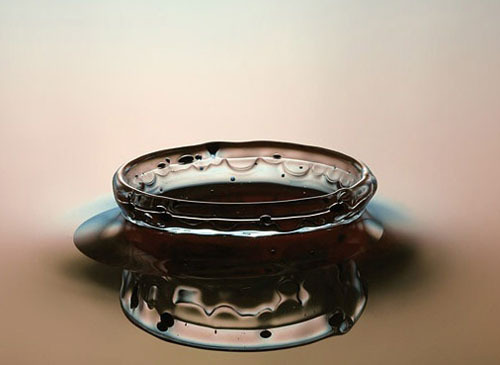
When people smash light bulbs and pop balloons they use a sound
trigger to fire the flash. Capturing flying bullets and splashing
drops typically requires a photo-sensor that recognizes when
a beam of light is interrupted. In either case, once the trigger
is tripped, a timing device delays and then fires the flash.
My
timing/control circuit controls the timing of the drop release
as well as the flash firing, so there is no sensor involved.
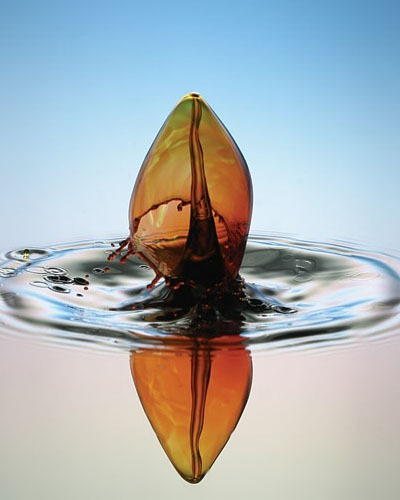
More challenging than controlling flashes and digital cameras,
and less well documented, is handling liquids. Not being electronic
or mechanical, a fluid is nonlinear – a small difference
in conditions can make a big difference in behavior. It is
both beautiful and frustrating.
The parameters I have learned
to control are timing, position, size, speed, color, viscosity,
and surface tension of the drops.
I add plain food coloring to color them. I use glycerin to
vary viscosity and dishwasher rinse-aid to adjust surface tension.
The
most provocative event in my journey happened by accident, when
I was using a steady stream of drips flowing from a siphon.
In one frame, I saw a splash in a shape that just shouldn’t
be possible. I had captured one drop landing on top of the
rising splash of the previous drop. “If that can happen
on accident,” I
thought, “can I make it happen on purpose?”
Indeed,
I can.
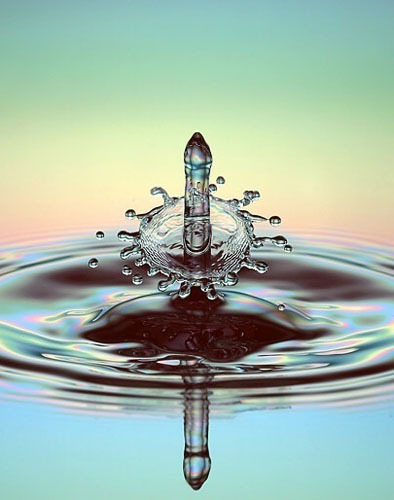
For most of my images, I know the shape I want before taking
the picture. Through experimentation and experience, I have
learned many of the possible shapes (or at least, ones that
should be
possible).
My control is not perfect, of course, so it may take me 10
or 20 or 50 tries to get just what I was looking for (or
close enough).
All of the best-laid plans notwithstanding, serendipity and
chance are my constant companions.
I use Photoshop to crop,
clean up the background a bit, remove a few extraneous droplets,
and adjust the color balance,
but I stop well short of manipulating the shape or placement
of
the drops.
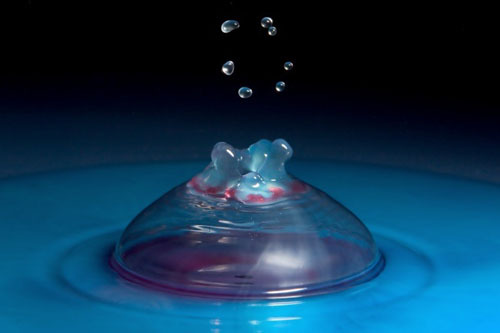
Conclusion
High-speed photography of drops and splashes has captivated
viewers for a century. Fluids in motion have a simple beauty
in their
complex dynamics. Images of that motion stopped seem to tap into
people’s
innate child-like sense of wonder, engaging their imagination.
I, for one, cannot seem to get enough of it.
Additional sources
for high-speed photography
Harold “Doc” Edgerton is
the father of the xenon flash tube and high-speed photography.
Search for his books on
Amazon.com.
Andrew Davidhazy, at the Rochester Institute of Technology,
www.rit.edu/~andpph, has good information on high-speed techniques,
as well as other
fascinating types of photography.
www.hiviz.com has techniques,
equipment diagrams, and kits.
Equipment
for can be purchased from www.bmumford.com and www.woodselec.com. |